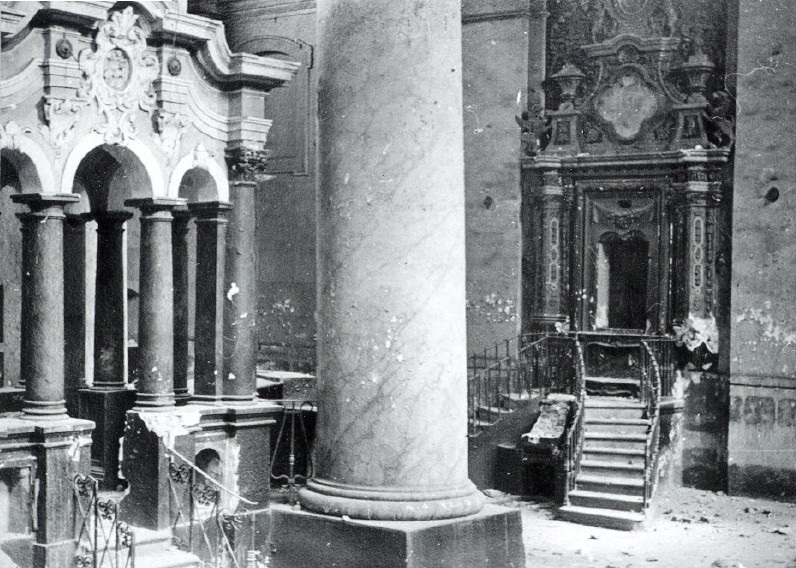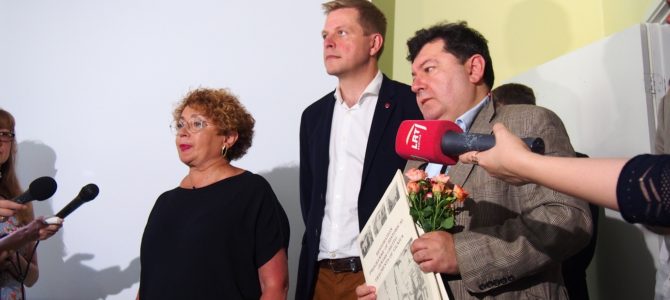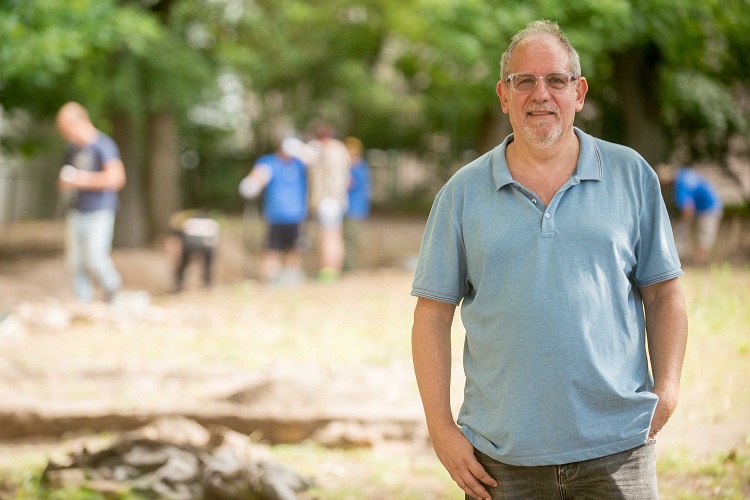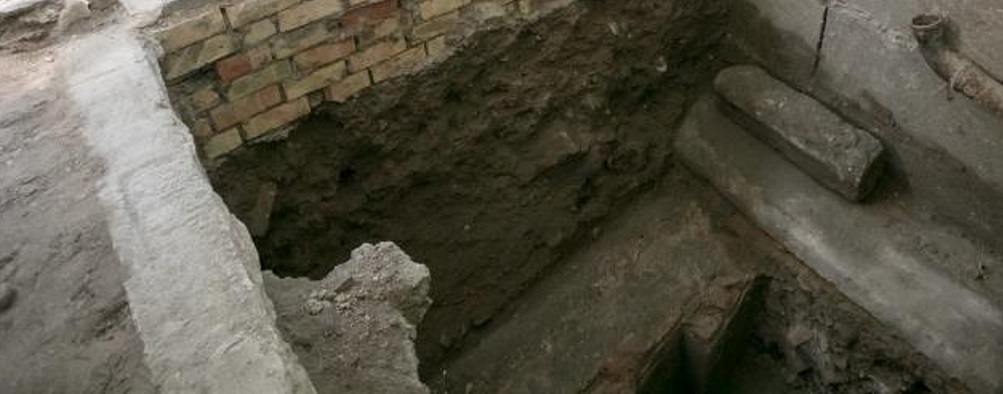
On July 26 reporters were invited to get a better look at the results of this year’s archaeological digs at the site of the former Great Synagogue in Vilnius.
An international team of Israel, American, Canadian and Lithuanian archaeologists made a number of discoveries this year, the third summer in a row digging has been conducted in and around the Soviet-era school built in 1952 on top of the former synagogue. Under one classroom the edge of the bima, the raised platform where the Torah is read, and the base of a column in the elaborate design of the bima were discovered. Lead archaeologist from the Israeli Antiquities Authority Dr. Jon Seligman explained to reporters the aron kodesh, or ark where the Torah is kept, would like be just under the fence bordering the street in the front of the school. He said the street had slightly shifted in location since the pre-war period. The bima and the ark form the main axis around which activities take place in the main hall of the synagogue.
Digging resumed in the playground and uncovered the men’s mikve next to the women’s discovered last year and suspected the year before. The mikvot constituted a two-storey building behind the synagogue from the side of the street still called Jewish street. A mikve is a bathing facility used for ritual purification. Two areas uncovered displayed what appeared to be almost new, slightly over-sized ceramic bathroom tiles, alternating squares of white and an orangish-red color.
Adjacent to the mikve building archaeologists determined the exact location of the outer wall of the synagogue proper this year.
An important find this summer which went mostly unreported was the unearthing of the entrance to the Great Synagogue. The story is the synagogue was built partly submerged in the ground so that it wouldn’t be too tall from street level and not offend Christian sensibilities by overshadowing the tall church next to it. Hence worshipers descended into the main space by an entrance which led down from the side of the synagogue, not on Jewish street. Dr. Seligman and his team determined that stairway is parallel to the driveway just inside the gate in the back of the school.
A portion of the floor of the main hall of the synagogue was also uncovered and it was tiled with orange-colored brick-like tiles, Seligman said.

At the press conference on July 26 Seligman projected maps of the entire shulhoyf complex for reporters to demonstrate what he was talking about. He turned the press conference over to other speakers including Vilnius mayor Remigijus Šimašius, Lithuanian Jewish Community chairwoman Faina Kukliansky and MP Emanuelis Zingeris.
Emanuelis Zingeris said the discovery of the bima was an important moment in the story of the Great Synagogue.
“After the recreation of the Royal Castle, this location becomes the main place for restoration in the city of Vilnius. Currently the Royal Castle is showing an exhibit about manor culture of the grand dukes of Lithuania, but one has to understand that the Great Synagogue is also part of the legacy of the Grand Duchy. It is a testimony to 700 years of Jewish life. One can compare the significance of the Great Synagogue to the Wailing Wall just in terms of the religious intensity which was present here. Around it stood many synagogues, this is where the heart of Vilnius beat. Here we find the logic of the Renaissance we see in Italy, and the rhythm of all the small streets which was broken. I have recorded testimonies about how the synagogue was destroyed. One person spoke of a Soviet tank to which a line was attached which pulled down the wall of the synagogue in 1947. People stood around and watched as the site was destroyed and Stalin’s heroes destroyed our Old Town. Together we will attempt to restore everything and capture the world’s attention, of archaeologists first of all. Just imagine, this is where the aron kodesh stood with its doors, inscribed with God’s Ten Commandants, which is now in the Jewish Museum but which stood in the synagogue for 500 years and was a guiding star to the Jews of the world, not in Paris and London, but here, in Vilnius. A little bit at a time we will move towards making this place reflect the full picture of Vilnius as the Jerusalem of the North, the Jerusalem of Lithuania. All of us together will remember these people during the Pope’s visit,” Zingeris said.
Lithuanian archaeologist Justinas Račas, also supervising the archaeological dig, seconded the idea the Great Synagogue site could become one of the biggest tourist attractions in the world, and said Vilnius was deservedly called the Jerusalem of Lithuania because it was such a rich center of Jewish spiritual life. He said it wasn’t clear before whether the Soviet-era school building really needed to be torn down, but after the discovery of the bima it’s now clear much of the synagogue is still conserved under the surface.
Dr. Seligman joked that the preschool and then school principals had chosen the right place for their office, right above the bima. The complex two-level bima was built in the 17th century and featured four Tuscan columns around it plus eight Corinthian columns around its perimeter. Seligman was born in Great Britain, grew up in South Africa and now calls himself simply an Israeli. He has Litvak roots and his grandparents were from Kretinga, Šeduva and Vilnius in Lithuania and Wrocław in Poland.



